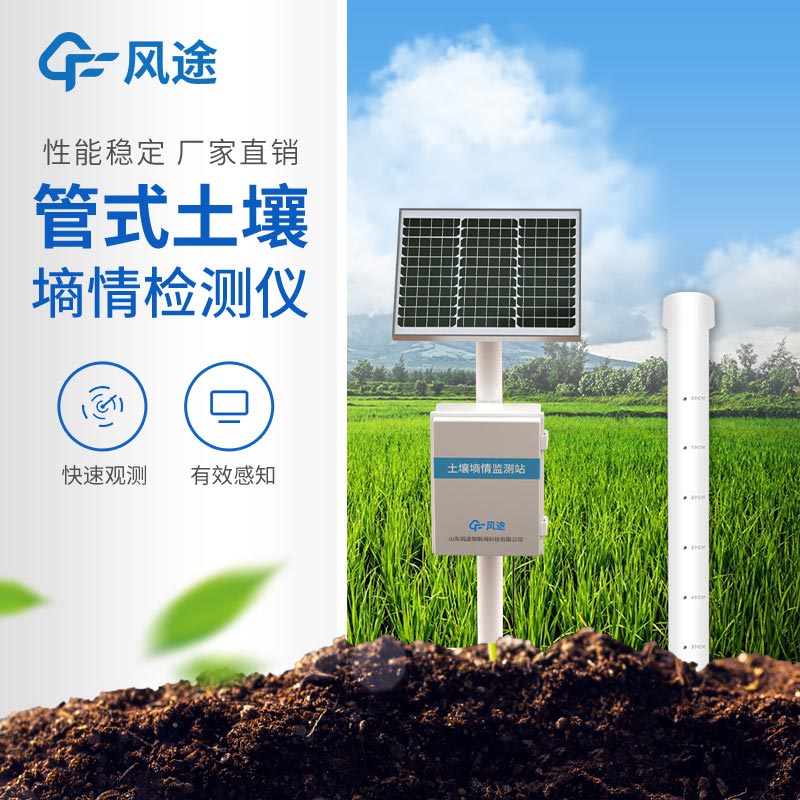Shandong Fengtu IOT Technology Co., Ltd
Sales Manager:Ms. Emily Wang
Cel,Whatsapp,Wechat:+86 15898932201
Email:info@fengtutec.com
Add:No. 155 Optoelectronic Industry Accelerator, Gaoxin District, Weifang, Shandong, China

Sales Manager:Ms. Emily Wang
Cel,Whatsapp,Wechat:+86 15898932201
Email:info@fengtutec.com
Add:No. 155 Optoelectronic Industry Accelerator, Gaoxin District, Weifang, Shandong, China
time:2024-02-07 11:19:04 source:Weather Station viewed:687 time
With the standardisation of agricultural technology, the tube soil moisture monitor has become an important equipment for large-scale planting sites. It can tell growers the moisture condition of the soil in real time, helping them to irrigate scientifically to avoid too much or too little moisture affecting crop growth. With this tool, growers are better able to predict soil moisture changes and respond in advance, thus improving crop drought tolerance and yield. In short, the Tube Soil Moisture Monitor makes farming more scientific and efficient, bringing better economic and ecological benefits to growers.
The core function of the Tube Soil Moisture Monitor is to comprehensively monitor key information about the environment in which crops are growing. This information includes soil temperature and humidity, as well as nitrogen, phosphorus and potassium content in the soil, soil pH and salinity. These parameters are accurately measured by specialised sensors. For example, soil humidity is monitored by soil moisture sensors, while the nitrogen, phosphorus and potassium content of the soil is detected by the corresponding sensors. Similarly, soil salinity is monitored by specialised sensors. Through these sensors, growers can understand the soil condition in real time and provide the most suitable growing environment for their crops.
Currently, tubular soil moisture monitors have been widely used in many industry sectors, such as agriculture, forestry, environmental protection, water conservancy, meteorology, etc., for monitoring and collecting environmental information. Meanwhile, it also plays an important role in the fields of water-saving irrigation, flower gardening, grass pasture, rapid soil testing, plant culture, greenhouse control and fine agriculture. These applications not only meet the needs of scientific research, production and teaching, but also provide strong support for the sustainable development of agricultural production.
With the standardisation of agricultural technology, tube-type soil moisture monitor has become an important equipment for large-scale planting bases. It can tell growers the soil moisture condition in real time and help growers to irrigate scientifically to avoid too much or too little moisture affecting the growth of crops. With this tool, growers are better able to predict soil moisture changes and respond in advance, thus improving crop drought tolerance and yield. In short, the Tube Soil Moisture Monitor makes farming more scientific and efficient, bringing better economic and ecological benefits to growers.
The core function of the Tube Soil Moisture Monitor is to comprehensively monitor key information about the environment in which crops are growing. This information includes soil temperature and humidity, as well as nitrogen, phosphorus and potassium content in the soil, soil pH and salinity. These parameters are accurately measured by specialised sensors. For example, soil humidity is monitored by soil moisture sensors, while the nitrogen, phosphorus and potassium content of the soil is detected by the corresponding sensors. Similarly, soil salinity is monitored by specialised sensors. Through these sensors, growers can understand the soil condition in real time and provide the most suitable growing environment for their crops.
Currently, tubular soil moisture monitors have been widely used in many industry sectors, such as agriculture, forestry, environmental protection, water conservancy, meteorology, etc., for monitoring and collecting environmental information. Meanwhile, it also plays an important role in the fields of water-saving irrigation, flower gardening, grass pasture, rapid soil testing, plant culture, greenhouse control and fine agriculture. These applications not only meet the needs of scientific research, production and teaching, but also provide strong support for the sustainable development of agricultural production.

industrial sensors Measuring the physical characteristics or changes in the industrial environment, types are: temperature sensors, pressure sensors, level sensors, infrared sensors, smoke sensors, optical sensors, etc....
Automatic ambient air quality monitoring station is an important branch in the field of environmental monitoring in China, which realizes environmental quality management by monitoring and analyzing atmospheric environmental quality. With the continuous development of China's economy and the inc...
The distribution of global water resources is uneven, and many regions are facing serious water shortage problems. With population growth, economic development and the acceleration of urbanization, the demand for water resources is constantly increasing, while the available water resources are very...
instrument to measure the weather Instrument to measure the weather around us, it integrates hygrometer, anemometer, barometer, rain gauge and so on....